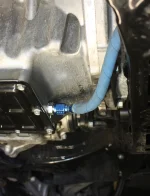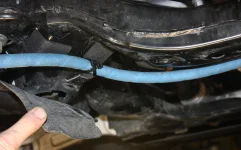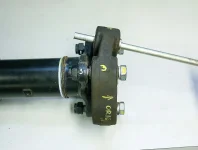arcman
Registered Member
- Joined
- Nov 24, 2018
- Messages
- 379
- Reaction score
- 224
- Points
- 43
- Genesis Model Type
- 2G Genesis Sedan (2015-2016)
Finally got around to getting the car up in the air to do some investigating. With three items on the list, this turned into a two-dayer. Rotate tires, craft a drain line so I don't have to lift the car to change oil (yeah, I did just buy a vacuum pump but it will be quicker this way). The third was the driveline shutter/noise.
I actually got quite elaborate/anal on this (I tend to do this on a lot of things). I set up three lav mics and laptops running Audicity to record where the noise was coming from. One mic on the rear u-joint on the front prop shaft, one on the rubber coupler and one on the mid bearing/U-joint.
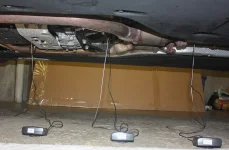
With the car up on stands under the suspension so the axles weren't in droop, I ran the car up to 30mph. Expecting to hear the usual clicking, it didn't happen. But... it had a nasty vibration like I've never felt before. My car just emits a few minutes of clicking from under the console and then it goes away. One key thing with this test is the wheels were off. So that ruled them out.
Since the clicking I expected didn't happen, the mics didn't help much. Big waste of time in setting all that crap up.
Here's the reason you can kiss off the tire theory... I disconnected the rear driveshaft rubber coupler from the trans, ran it up again to 30mph and the vibration is GONE. (I assume the clicking also) Too bad you can't road test it this way without completely removing the rear driveshaft.
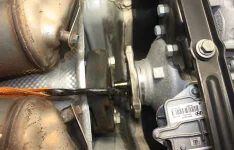
Before I bolt it all back up, I wanted to check with others here who have the vibration. I've never really noticed the vibration, maybe because the 30mph portion of roads from my house to town or to the interstate are so rough, I never feel it. After five miles there's no clicking. This only happens on the initial drive of the day.
Does your vibration lessen after a few miles? If that is the case, I'm leaning again to the rubber coupler. If it were a rear driveshaft balance issue, it would be there every time the car was at 30mph.
Here's a couple pics of the drain hose. I found a 14mm x 1.5 to AN6 adapter for the pan. A hose which leads to the outside of the car behind the front left fender well liner. I put an old ratty piece of firesleeve over the hose where it is near the exhaust to protect it from heat. I ty-rapped it near the outer edge of the undertray panel and when it comes time to drain the oil, I'll just snip the ty-rap and let it hang out over a pan.
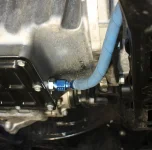
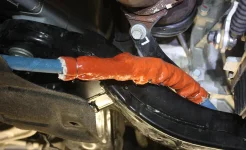
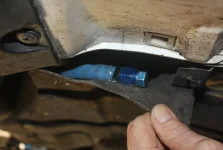
I actually got quite elaborate/anal on this (I tend to do this on a lot of things). I set up three lav mics and laptops running Audicity to record where the noise was coming from. One mic on the rear u-joint on the front prop shaft, one on the rubber coupler and one on the mid bearing/U-joint.

With the car up on stands under the suspension so the axles weren't in droop, I ran the car up to 30mph. Expecting to hear the usual clicking, it didn't happen. But... it had a nasty vibration like I've never felt before. My car just emits a few minutes of clicking from under the console and then it goes away. One key thing with this test is the wheels were off. So that ruled them out.
Since the clicking I expected didn't happen, the mics didn't help much. Big waste of time in setting all that crap up.
Here's the reason you can kiss off the tire theory... I disconnected the rear driveshaft rubber coupler from the trans, ran it up again to 30mph and the vibration is GONE. (I assume the clicking also) Too bad you can't road test it this way without completely removing the rear driveshaft.

Before I bolt it all back up, I wanted to check with others here who have the vibration. I've never really noticed the vibration, maybe because the 30mph portion of roads from my house to town or to the interstate are so rough, I never feel it. After five miles there's no clicking. This only happens on the initial drive of the day.
Does your vibration lessen after a few miles? If that is the case, I'm leaning again to the rubber coupler. If it were a rear driveshaft balance issue, it would be there every time the car was at 30mph.
Here's a couple pics of the drain hose. I found a 14mm x 1.5 to AN6 adapter for the pan. A hose which leads to the outside of the car behind the front left fender well liner. I put an old ratty piece of firesleeve over the hose where it is near the exhaust to protect it from heat. I ty-rapped it near the outer edge of the undertray panel and when it comes time to drain the oil, I'll just snip the ty-rap and let it hang out over a pan.






